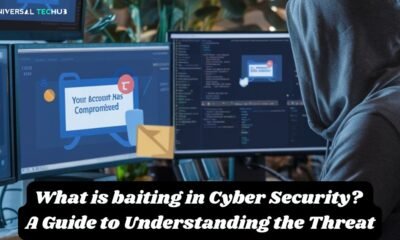Social engineering attack
Baiting in cyber security: Protect Yourself from Cyberattacks

Despite the continuous improvement of cybercriminals’ techniques, baiting in cyber security remains one of their most effective growth tools. Due to advancements in software and physical defenses against cyberattacks, the only reliable attack vector that thieves can still exploit is deceiving employees.
A human factor was present in 74% of breaches, according to Verizon’s 2023 Data Breach Report.
A further indication of human susceptibility to cyberattacks is the 2023 Gone Phishing Tournament, which tested more than 1.3 million users and discovered that 10% of workers fall for phishing schemes.
These figures clearly show how, despite advances in cybersecurity technology, human mistake or manipulation continues to be a crucial vulnerability that attackers exploit.
Cybercriminals are employing increasingly creative strategies to seize unsuspecting employees during periods of stress or weakness. Baiting, a prevalent form of social engineering that has been causing havoc all over the world, shows up.
This page will explain the cyber threat, its variations, how to identify these attacks, and how to take precautions against fraud.
What is baiting in cyber security?
What is baiting in cyber security? Although “phishing” attacks have been known for a while, baiting goes one step further by attracting internet users with a tempting offer to encourage interaction.
A provocative or fascinating file, a tempting link, an alluring image, a “gift,” or even the assurance of access to private information can all be considered “bait.”
This bait taps into human urges and drives, such as voyeurism, avarice, vanity, righteous anger, or simply a longing for the forbidden fruit.
Once the hacker has eaten the bait, they can then execute exploits such as malware installation, data/identity theft, account takeover, or network intrusion.
The primary characteristic that sets baiting apart from other techniques is the unknowing victim’s active facilitation of malicious behavior through their knowingly chosen acceptance of the bait. For instance, they opt to steal attractively exposed data or download and execute malware masquerading as video software.
For the bait to elicit that crucial click that establishes the hook, it must appear authentic and alluring enough. Therefore, hackers delve into the psychology of what people find appealing on the internet based on human motivations, current events, trends, and more. They then use that desire as a tool for pushing individuals into unsafe situations.
Some of the baits that hackers employ may appear harmless at first glance, but they are barbed hooks that catch people who allow their curiosity to overcome them. Nonetheless, a lot of bait goes against moral principles to lure victims into willingly supporting cybercrimes. We’ll find some excellent illustrations of various baiting strategies.
Read more:
| Spear Phishing Email: A Dangerous Threat | Spear Phishing Examples: Protect Yourself |
| Spear Phishing Attack: A Targeted Cyber Threat | Spear phishing vs phishing: Understand the Risks |
Recognizing the various types of bait
There are several variations of baiting that, depending on the circumstance, might increase their success rate. To properly recognize each variation of baiting as it occurs, one must be aware of its many forms.
Malvertising
Malvertising is as historically significant as the Internet itself and is probably the most common kind of baiting. One of the most effective methods to propagate a fraud is to create fake advertisements that promise substantial rewards. In this case, cybercriminals take advantage of their victims’ moment of distraction while they browse the internet.
Additionally, malvertising can originate from a variety of platforms, including SMS and email. Another variation may originate from social media when hackers create a fake profile posing as a business holding a competition and informing consumers that they have won.
Baiting with spears
This kind of baiting focuses on a particular company and its employees. To spot any baiting attempts, extensive study is required to learn about the numerous details of the workplace.
Since the crooks acquired a lot of material to convince their victims, this approach usually works quite well.
The promise of financial advantages, such as a prize for completing a work fast or a higher pay rate for the time the activity is completed, is typically used as the bait in spear baiting.
Physically engaging
Although the majority of baiting attempts take place online, they may also be quite effective offline.
Hackers take advantage of human curiosity and nature by leaving a USB device or QR code in a public area. They hope that someone will plug the device in or scan the code, which will send them to a malicious website or install malware on their computer.
How to Identify Baiting Attempts
Baiting is only effective if the victim accepts the offer. When dealing with any cyber threat, especially baiting, it’s crucial to remember that if an offer appears excessively favorable, it’s likely a fraudulent scheme.
In addition to being an unexpected benefit or windfall, this circumstance may also present itself as a job offer or a wage that is significantly higher than the going rate in the market.
Likewise, you must be extremely cautious and suspicious of any attachments or links in unwelcome messages from someone you don’t know. Verifying the desired job or information with the individual via another route is always preferable, even if it comes from a reliable source.
Even though physical baiting is easier to stop, it can still be effective in large quantities. Here, the general rule of thumb is rather straightforward: Never connect an unfamiliar USB stick to your computer, and before scanning a QR code, be sure it comes from a reliable source.
Discover more:
A Culture Aware of Cybersecurity to Prevent Baiting
People frequently believe they are immune to strategies like baiting, which creates a false sense of security and increases the attack’s success rate. However, baiting attacks are often less obvious than a wealthy long-lost relative or a famous Nigerian prince donating billions.
Baiting becomes more risky as it gets more complex and nuanced. Because baiting may take many different forms, cyber security training is frequently insufficient to combat it.
Conducting frequent simulations focused on this type of cyber threat is crucial, as the contextual understanding of baiting is optimal.
These exercises not only assist you in identifying which employees are at risk, but they may also teach you how to address the circumstances or surroundings that initially exposed them to this attack.
Conclusion
Baiting in cyber security is a dishonest yet effective strategy that attackers employ to take advantage of people’s trust and curiosity. Only by understanding the many forms of baiting attacks and how baiting functions in cybersecurity can people and organizations better protect against becoming victims.
Explore more:
-

 Phishing attack8 months ago
Phishing attack8 months agoWhat is Spear Phishing and How You Can Identify This Scam?
-

 Social engineering attack10 months ago
Social engineering attack10 months agoBaiting Attacks Explained: A Closer Look at Cyber Threat Tactics
-

 Social engineering attack8 months ago
Social engineering attack8 months agoWhat are Social Engineering Attacks – A Complete Guide to Cyberattacks Prevention
-

 Social engineering attack9 months ago
Social engineering attack9 months agoSpear Phishing Attack: A Targeted Cyber Threat
-

 Social engineering attack10 months ago
Social engineering attack10 months agoWhat is spear phishing attack? A detailed guide
-

 Social engineering attack10 months ago
Social engineering attack10 months agoWhat is spear phishing in cyber security?
-

 Phishing attack4 months ago
Phishing attack4 months agoWhy is Phishing Still a Major Cyber Threat? Everything You Need to Know
-

 Phishing attack8 months ago
Phishing attack8 months agoWhat Are Phishing Emails? A guide for you
























